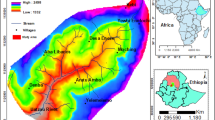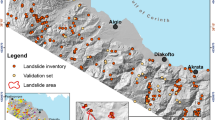Abstract
GIS-based landslide susceptibility maps for the Kankai watershed in east Nepal are developed using the frequency ratio method and the multiple linear regression technique. The maps are derived from comparing observed landslides with possible causative factors: slope angle, slope aspect, slope curvature, relative relief, distance from drainage, land use, geology, distance from faults and mean annual rainfall. The consistency of the maps is evaluated using landslide density analysis, success rate analysis and spatially agreed area approach. The first two analyses produce almost identical quantitative results, whereas the last approach is able to reveal spatial differences between the maps and also to improve predictions in the agreed high landslide-susceptible area.









Similar content being viewed by others
References
Aleotti P, Chowdhury R (1999) Landslide hazard assessment: summary, review and new perspectives. Bull Eng Geol Environ 58:21–44
Baeza C, Corominas J (2001) Assessment of shallow landslide susceptibility by means of multivariate statistical techniques. Earth Surf Process Landf 26(12):251–1263
Bijukchhen SM, Kayastha P, Dhital MR (2012) A comparative evaluation of heuristic and bivariate statistical modelling for landslide susceptibility mappings in Ghurmi–Dhad Khola, east Nepal. Arab J Geosci. doi:10.1007/s12517-012-0569-7
Brabb EE (1984) Innovative approaches to landslide hazard and risk mapping. Fourth Int Symp Landslides Can Geotech Soc Tor Can 1:307–324
Carrara A (1983) Multivariate models for landslide hazard evaluation. Math Geol 15(3):403–426
Çevik E, Topal T (2003) GIS-based landslide susceptibility mapping for a problematic segment of the natural gas pipeline, Hendek (Turkey). Environ Geol 44:949–962
Chalise SR (2001) An introduction to climate, hydrology, and landslide hazards in the Hindu Kush–Himalayan region. In: Tianchi L, Chalise SR, Upreti BN (eds) Landslide hazard mitigation in the Hindu Kush–Himalayas. ICIMOD, Kathmandu, pp 51–62
Chung CF, Fabbri AG (1993) Representation of geoscience information for data integration. Nat Resour Res 2(2):122–139
Chung CF, Fabbri AG (1999) Probabilistic prediction models for landslide hazard mapping. Photogram Eng Remote Sens 65(12):1389–1399
Chung CF, Fabbri AG, van Westen CJ (1995) Multivariate regression analysis for landslide hazard zonation. In: Carrara A, Guzzetti F (eds) Geographical information systems in assessing natural hazards. Kulwer Academic, Dordrecht, pp 107–133
Cruden DM, Varnes DJ (1996) Landslide types and processes. In: Turner AK, Schuster RL (eds) Landslides—investigation and mitigation. Special report 247, Transportation Research Board, National Research Council, pp 36–75
Dahal RK, Hasegawa S, Nonomura A, Yamanaka M, Dhakal S, Paudyal P (2008) Predictive modeling of rainfall-induced landslide hazard in the Lesser Himalaya of Nepal based on weights-of-evidence. Geomorphology 102:496–510
Dai FC, Lee CF (2002) Landslide characteristics and slope instability modeling using GIS Lantau Island, Hong Kong. Geomorphology 42:213–238
Dai FC, Lee CF, Li J, Xu ZW (2001) Assessment of landslide susceptibility on the natural terrain of Lantau Island, Hong Kong. Environ Geol 40(3):381–391
Deoja BB, Dhital MR, Thapa B, Wagner A (1991) Mountain risk engineering handbook. International Centre for Integrated Mountain Development (ICIMOD), Kathmandu, p 875
Dhakal AS, Amada T, Aniya M (2000) Landslide hazard mapping and its evaluation using GIS: an investigation of sampling schemes for a grid-cell based quantitative method. Photogram Eng Remote Sens 66(8):981–989
Fell R, Corominas J, Bonnard C, Cascini L, Leroi E, Savage WZ, JTC-1 Joint Technical Committee on Landslides and Engineered Slope (2008) Guidelines for landslide susceptibility, hazard and risk zoning for land use planning. Eng Geol 102:85–98
Ghosh S, van Westen CJ, Carranza EJM, Ghosal TB, Sarkar NK, Surendranath M (2009) A quantitative approach for improving the BIS (Indian) method of medium-scale landslide susceptibility. J Geol Soc India 74:625–638
Ghosh S, Günther A, Carranza EJM, van Westen CJ, Jetter VG (2010) Rock slope instability assessment using spatially distributed structural orientation data in Darjeeling Himalaya (India). Earth Surf Process Landf 35(15):1773–1792
Gupta RP, Kanungo DP, Arora MK, Sarkar S (2008) Approaches for comparative evaluation of raster GIS-based landslide susceptibility zonation maps. Int J App Earth Obs Geoinf 10:330–341
Guzzetti F, Carrara A, Cardinali M, Reichenbach P (1999) Landslide hazard evaluation: a review of current techniques and their application in a multi-scale study, central Italy. Geomorphology 31:181–216
Hagen T (1969) Report on the geological survey of nepal, vol. 1. Preliminary reconnaissance. Mém De La Soc Helvétique Des Sci Nat 86(1):1–185
Hansen A (1984) Landslide hazard analysis. In: Brunsden D, Prior DB (eds) Slope instability. Wiley, New York, pp 523–602
Hutchinson JN (1995) Keynote paper: Landslide hazard assessment. In: Bell DH (ed) Landslides. Balkema, Rotterdam, pp 1805–1841
Kanungo DP, Arora MK, Sarkar S, Gupta RP (2006) A comparative study of conventional, ANN black box, fuzzy and combined neural and fuzzy weighting procedures for landslide susceptibility zonation in Darjeeling Himalayas. Eng Geol 85:347–366
Kanungo DP, Arora MK, Gupta RP, Sarkar S (2008) Landslide risk assessment using concepts of danger pixels and fuzzy set theory in Darjeeling Himalayas. Landslides 5:407–416
Kanungo DP, Arora MK, Sarkar S, Gupta RP (2009) A fuzzy set based approach for integration of thematic maps for landslide susceptibility zonation. Georisk: Assess Manag Risk Eng Syst Geohazards 3(1):30–43
Kayastha P, De Smedt F, Dhital MR (2010) GIS based landslide susceptibility assessment in Nepal Himalaya: a comparison of heuristic and statistical bivariate analysis. In: Malet JP, Glade T Casagli N (eds) Mountain risks: bringing science to society. CERG Editions, pp 121–128
Kayastha P, Dhital MR, De Smedt F (2012) Landslide susceptibility mapping using the weight of evidence method in the Tinau watershed, Nepal. Nat Hazards 63(2):479–498
Lee S (2004) Application of likelihood ratio and logistic regression models to landslide susceptibility mapping using GIS. Environ Manag 34(2):223–232
Lee S, Min K (2001) Statistical analysis of landslide susceptibility at Yongin, Korea. Environ Geol 40:1095–1113
Lee S, Choi J, Min K (2002) Landslide susceptibility analysis and verification using the Bayesian probability model. Environ Geol 43:120–131
Oguchi T (1997) Drainage density and relative relief in humid steep mountains with frequent slope failure. Earth Surf Process Landf 22(2):107–120
Ohlmacher CG, Davis CJ (2003) Using multiple regression and GIS technology to predict landslide hazard in northeast Kansas, USA. Eng Geol 69:331–343
Poudyal CP, Chang C, Oh H, Lee S (2010) Landslide susceptibility maps comparing frequency ratio and artificial neural networks: a case study from the Nepal Himalaya. Environ Earth Sci 61:1049–1064
Reger JP (1979) Discriminant analysis as a possible tool in landslide investigations. Earth Surf Process Landf 4(3):267–273
Sarkar S, Kanungo DP (2004) An integrated approach for landslide susceptibility mapping using remote sensing and GIS. Photogram Eng Remote Sens 70(5):617–625
Sarkar S, Kanungo DP, Patra AK, Kumar P (2006) GIS based landslide susceptibility mapping—a case study in Indian Himalaya. In: Marui H et al (eds) Disaster mitigation of debris flows, slope failures and landslides. Universal Academy, Tokyo, pp 617–624
Sarkar S, Kanungo DP, Patra AK, Kumar P (2008) GIS based spatial data analysis for landslide susceptibility analysis. J Mt Sci 5:52–62
Sharma CK (1990) Geology of Nepal Himalaya and adjacent countries. Sangeeta Sharma, Kathmandu, p 479
Thapa PB, Dhital MR (2000) Landslide and debris flows of 19–21 July 1993 in the Agra Khola watershed of central Nepal. J Nepal Geol Soc 21:5–20
Upreti BN, Dhital MR (1996) Landslide studies and management in Nepal. ICIMOD, Nepal, p 87
Uromeihy A, Mahdavifar MR (2000) Landslide hazard zonation of the Khorshrostam area, Iran. Bull Eng Geol Environ 58:207–213
van Westen C (1997) Statistical landslide hazard analysis ILWIS 2.1 for Windows application guide. ITC, Enschede, pp 73–84
van Westen CJ, Rengers N, Soeters R (2003) Use of geomorphological information in indirect landslide susceptibility assessment. Nat Hazards 30(3):399–419
Varnes DJ (1984) International association of Engineering geology commission on landslides and other mass-movements: Landslide hazard zonation: A review of principles and practice. UNESCO, Paris, p 63
Yin KL, Yan TZ (1988) Statistical prediction model for slope instability of metamorphosed rocks. In: Bonnard C (ed) Proc. 5th Int. Sym. on Landslides, Lausanne. Balkema, Rotterdam, pp 1269–1272
Acknowledgments
The Department of Survey, the Department of Hydrology and Meteorology and the Department of Mines and Geology, Government of Nepal, provided data used in this study. The Flemish Inter-University Council (VLIR), Belgium, provided a Ph.D. scholarship for the first author to carry out this research. The authors would also like to acknowledge the anonymous reviewers for their constructive suggestions.
Author information
Authors and Affiliations
Corresponding author
Rights and permissions
About this article
Cite this article
Kayastha, P., Dhital, M.R. & De Smedt, F. Evaluation of the consistency of landslide susceptibility mapping: a case study from the Kankai watershed in east Nepal. Landslides 10, 785–799 (2013). https://doi.org/10.1007/s10346-012-0361-5
Received:
Accepted:
Published:
Issue Date:
DOI: https://doi.org/10.1007/s10346-012-0361-5




